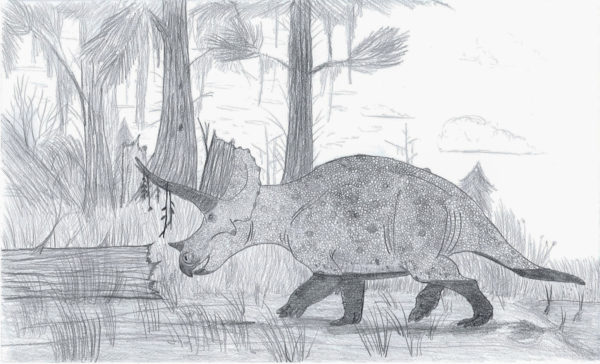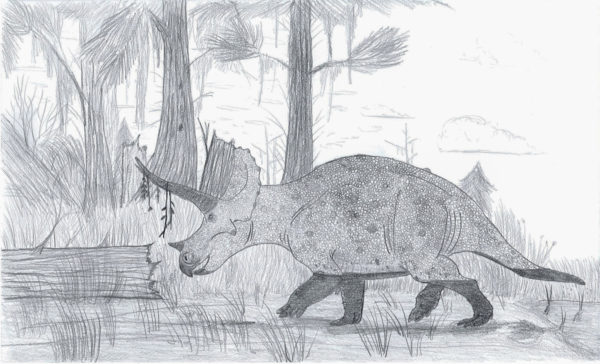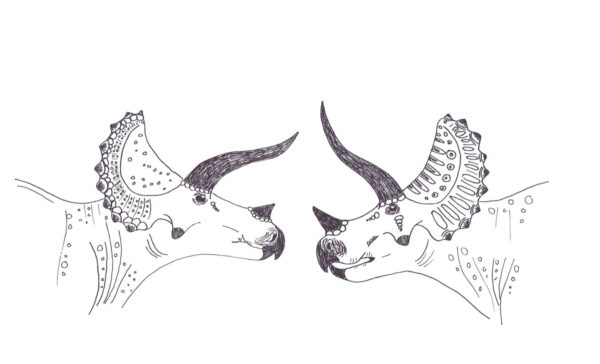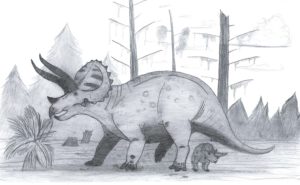
Quick- picture everyone’s favourite horned dinosaur, Triceratops. More specifically, picture it alive, in its ecosystem, doing typical Triceratops things. Okay, how many people imagined this dinosaur engaged in mortal combat with its eternal nemesis, Tyrannosaurus? I don’t gamble, but if I did, I’d bet at least a few people imagined this. I find that when Triceratops is reconstructed in popular media doing more than just standing pretty to be admired, it’s usually doing one of two things: squaring off against the perpetual assault of T. rex (as in countless paintings, dioramas, exhibits, and films), or lying on the ground dead or dying. While I understand the appeal of the dramatic showdown between the last giant carnivore and horn-face of the Cretaceous, I think history has done a disservice to this dinosaur. It was more than just Tyrannosaurus chow on four legs. So let’s get a look into a day in the life of Triceratops.
The giant three-horned face was native to western North America, a region now dominated by vast, arid prairie and rocky badlands. It was discovered by fossil hunter John Bell Hatcher and named by the Monopoly Man of paleontology himself, Othniel Charles Marsh (Marsh 1889). At the time, the great Western Interior Seaway, which had for so long divided the landmasses of Laramidia and Appalachia, was quickly receding, and the continent of North America was taking shape. For ages, dinosaurs had thrived in the lush strip of land between the newly risen Rocky Mountains and the warm, shallow seaway, an environment ideal for their eventual burial and fossilization.

A Triceratops emerges from its muddy wallow as the heat of the day begins to fade. By Nicholas Carter, based on Scott Hartman’s skeletal
Triceratops existed here, and in some regions it occupied, it was the most common large animal of its day. During this time the inland seaway and its swampy peripheries, which at its maximum reached almost to the mountains, had shrunken down to cover the modern regions of North Dakota, the Saskatchewan-Manitoba border, and continued on gently northwest to the Arctic Ocean. Triceratops is known from end-Cretaceous formations of Alberta, Saskatchewan, the Dakotas, Wyoming, Colorado, and Montana. It seems to have preferred the lusher, swampy regions close to the southern end of the sea as opposed to the drier, wooded inland habitats, since it’s less common the further north and west you get from the Hell Creek Formation where Triceratops dominates.
There’s actually two different species of Triceratops known, with one occurring slightly after the other. The first to be described was Triceratops horridus, which may have directly evolved into the slightly younger Triceratops prorsus. The differences between the two are subtle- T. horridus tends to have a short nasal horn, forward-directed orbital horns, and a fairly elongate snout, while T. prorsus bears a longer nasal horn, more upward-directed orbital horns, and a shorter, deeper snout. Both, at max size, were a bit larger and heavier than a really big elephant. Triceratops coexisted with a variety of other herbivores, some of them of relatively modest size like Thescelosaurus, Pachycephalosaurus, and a few ostrich-like theropods. Some of its peers were pretty gigantic in size, such as Edmontosaurus, Denversaurus, and Ankylosaurus, and it’s hard to imagine how much space and food would be necessary for all these big plant eaters. However, research on the feeding strategies and anatomy of big herbivores from Dinosaur Provincial Park shows how these dinosaurs got by without directly getting in each other way (Mallon & Anderson 2013).

Triceratops horridus on the left and Triceratops prorsus on the right. Which one is the ‘definitive’ Triceratops to you? By Nicholas Carter
We have a pretty good idea about the life appearance of Triceratops, at least as far as its post-cranial region goes. Skin impressions from this dinosaur show a distribution of large, somewhat pointed tubercles surrounded by smaller yet still pretty darn big scales. With the discovery of keratinous bristles on the tail of the primitive horned dinosaur Psittacosaurus of Asia, some like to imagine Triceratops and its cousins sporting similar features in their skin (Mayr et al. 2002). However, no kind of bristle-like structure has been found in advanced horned dinosaurs yet, so the jury’s still out there. We’re also unsure of what the head and face looked like in life. Obviously Triceratops had its characteristic frill and horns, and scientists are confident that sheaths of keratin covered the bony horn cores in life, the same as the horns of modern mammals like sheep and cattle. What we aren’t sure of, though, is how far this covering of keratin grew over the face (for those not in the know, keratin is a hard, tough protein that covers structures in animals like claws, horns, scales, and beaks. It also makes up your hair and fingernails). Conservative approaches have the keratin sheaths stopping at the base of the horn cores, but some experts argue that the entire face, including the frill, was encased in keratin. A skull in the Canadian Museum of Nature’s collection, possibly preserving traces of skin, will surely illuminate the truth of Triceratops’ facial covering. The external horns themselves may not have completely matched the shape of the bony cores either. Paleontologists have suggested that, assuming the horn coverings grew in the same manner as modern horned mammals, Triceratops should wind up with long and wildly curled horn sheathes. While this is still an informal theory, it makes sense to me.
The everyday behaviour of Triceratops may also not be what many readers expect. Being a big, horned, plant-eating animal from western North America, early paleontologists often drew parallels between Triceratops and bison. The dinosaur was envisioned roaming across the plains in large herds, keeping the young ones close to the center of the group for protection and even encircling them like muskoxen when predators appeared. However, bison aren’t actually the best modern analogue for this dinosaur. It’s true that several horned dinosaur species like Centrosaurus, Styracosaurus, and Pachyrhinosaurus lived in large to massive herds, and are found in huge boenebeds today. Triceratops, though extremely common in some areas, is not known from any sort of mass death assemblage, and no more than three individuals have ever been found associated together (Mathews et al. 2009). It seems like this species either lived mostly on its own or in small family groups, not forming mega-herds like earlier ceratopsids.

An adult Triceratops browses along a dry mud flat while junior seeks shade under her tail. Did the young ever interact with their parents in this way? We still aren’t sure. By Nicholas Carter
While it might be fanciful, I like to imagine Triceratops more like the dinosaurian equivalent of the Asian water buffalo, roaming alone or in small groups through lush forests, browsing on vegetation, and lounging in pools, swamps, or mud wallows during the hot periods of the day. Unlike to broad, shovel-like bills of duck-billed dinosaurs, ceratopsians had very narrow, pointed beaks with powerful chewing muscles. The narrow mouth and low-set head of Triceratops hints that it had a more selective diet than its peers like the more indiscriminate hadrosaur Edmontosaurus. Triceratops probably chose tougher, more fibrous plants, using its powerful beak and arsenal of teeth to pluck and chop cycads and other rough plants. Some authors have suggested that, very occasionally, Triceratops would partake in meat when it was available. While this might seem strange, it’s not actually unreasonable to suggest this might have happened from time to time. It’s not unheard of at all for modern herbivores to snack on relatively fresh carrion when they get the chance. Even live predation in herbivores has been seen- deer for example are well known to eat baby birds and other small animals when they come across them. These, after all, are essentially handy little packs of protein to a large mammal trying to get by on vegetation, so why not take advantage of it? There’s nothing in the fossil record that insists Triceratops didn’t behave this way either, and its strong beak and teeth made it fairly well-equipped to handle fresh carrion and such (Ostrom 1966).
It’s always been more or less assumed that Triceratops was a fairly aggressive dinosaur, with its horns and tank-like body conjuring images of snorting, charging hoofed mammals like rhinos or bison, creatures that can and have inflict nasty damage to both predators and people. Scars in the facial and frill bones of Triceratops seem to indicate that they probably did get into violent jousts with each other at least sometimes, but is this behaviour the rule or the exception to it? It’s obviously hard to get a full picture of an extinct animal’s behaviour. You might think that looking at analogous modern animals would be helpful, after all this has helped us shape our image of Triceratops as a bad-tempered herbivore. It’s certainly true that some of the most dangerous large animals today are herbivores. Animals like moose, bison, hippos, elephants, and rhinos are all more than capable of killing humans and in some places are responsible for more human deaths than predators are (it must be said, though, that many cases of injury and death from big herbivores in places like parks and such are preventable and more a circumstance of humans being in the wrong place). However, let’s look at rhinos specifically. The black rhino (Diceros bicornis), which sadly is nearly as extinct as Triceratops itself, is notoriously aggressive in the wild, with stories claiming they’ll sometimes charge even inanimate objects. The contemporary white rhino (Ceratotherium simum), on the other hand, is reported to be much more docile and placid by comparison. I don’t know how much truth there is to this, but it goes to show that there can be a wide range in behavoural tendencies for fairly similar modern animals, and we can’t fully predict it just by looking at the animal’s shape and potential alone. Perhaps Triceratops was a mostly gentle giant, but it could have equally been an ill-tempered brute. Maybe we would see differing trends in aggression between the different species of Triceratops, or even different types of horned dinosaurs altogether.
Much like the arms of Tyrannosaurus, people have long wondered about the use of Triceratops’ headgear. Sexual selection, the art of being able to pass on one’s genes, is now usually posited as the main driving force in the evolution of ceratopsian frills and horns, and it makes sense. Sexual selection is responsible for elaborate display structures like the bright colours and elaborate tail fans that many male birds today use to attract females. In the case of Triceratops, it’s like a friend of mine always says- the bigger the frill, the bigger the thrill. It wouldn’t be surprising if the frill of Triceratops, especially in males, turned out to be brightly coloured. Perhaps they even changed colour during the breeding season, like salmon turning vibrant red during spawning. Who knows?
It’s important to note, however, that just because use as a mating display was the main point of all that headgear, doesn’t necessarily mean it was the only point. Early paleontologists first thought that the frill was there to protect the back of the neck from predator attacks. This doesn’t hold up though, since a tyrannosaur wouldn’t have too much trouble biting right through that frill, and in fact they may have served as handy levers for tyrannosaurs to rip Triceratops heads off with to access the bulky neck muscles. But here we are again seeing Triceratops as just Tyrannosaurus food waiting to be eaten…
We know that they almost certainly used their horns and frills for fighting with each other at least occasionally (Tanke & Farke 2006), and bitten-off horn cores confirm the obvious- that the horns were the main point of engagement with Tyrannosaurus during unfriendly encounters (Happ 2008). Triceratops horns, in a functional way at least, may have been a lot like deer antlers, being used for display and intimidation, fighting rivals, and fending off predators. Is that the only thing they were good for, though? Large modern animals that bear horns and antlers have found all sorts of side-uses for their headgear, such as clearing snow or vegetation, stripping bark off trees, rooting through the soil, and probably other things as well. These behaviours aren’t what horns and antlers evolved for specifically, but that doesn’t mean they don’t get the job done anyway. I don’t think unreasonable to suspect that perhaps Triceratops was using its horns for all kinds of purposes that we’ll never have direct evidence of.
Despite its otherworldly appearance, Triceratops was still an animal, one that didn’t necessarily obey our conceptions of what it could, or would, have done in life. A trip back in time to the latest Cretaceous of western North America would have seen far less theatrical battles to the death involving Triceratops and Tyrannosaurus than it would swampy woodlands full of Triceratops grunting, chewing, burping, and just acting the way big herbivores act. But Triceratops has the distinction of being one of the very last non-avian dinosaurs to ever live, a culmination of over 150 million years of evolution throughout the Mesozoic. While a day in the life of Triceratops was less dramatic and raw than we might imagine, it’s hard to say it doesn’t feel somewhat poetic that the final days of the dinosaurs were seen out by this wonderful animal and its eternal nemesis.
– By Nicholas Carter
References:
Happ, J. (2008). “An analysis of predator-prey behavior in a head-to-head encounter between Tyrannosaurus rex and Triceratops“. In Larson, P.; Carpenter, K. Tyrannosaurus rex, the Tyrant King (Life of the Past). Bloomington: Indiana University Press. pp. 355–368
Mallon JC, Anderson JS (2013) Skull Ecomorphology of Megaherbivorous Dinosaurs from the Dinosaur Park Formation (Upper Campanian) of Alberta, Canada. PLoS ONE 8(7): e67182
Marsh, O.C. (1889a). “Notice of new American Dinosauria”. American Journal of Science. 37(220): 331–336
Mathews, Joshua C.; Brusatte, Stephen L.; Williams, Scott A.; Henderson, Michael D. (2009). “The first Triceratops bonebed and its implications for gregarious behavior”. Journal of Vertebrate Paleontology. 29 (1): 286–290.
Mayr, G.; Peters, S. D.; Plodowski, G.; Vogel, O. (2002). “Bristle-like integumentary structures at the tail of the horned dinosaur Psittacosaurus” (PDF). Naturwissenschaften. 89 (8): 361–365.
Ostrom, J. H. (1966). “Functional morphology and evolution of the ceratopsian dinosaurs”. Evolution. 20 (3): 290–308.
Tanke, D. H.; Farke, A. A. (2006). “Bone resorption, bone lesions, and extracranial fenestrae in ceratopsid dinosaurs: a preliminary assessment”. In Carpenter, K. Horns and Beaks: Ceratopsian and Ornithopod Dinosaurs. Bloomington: Indiana University Press. pp. 319–347
